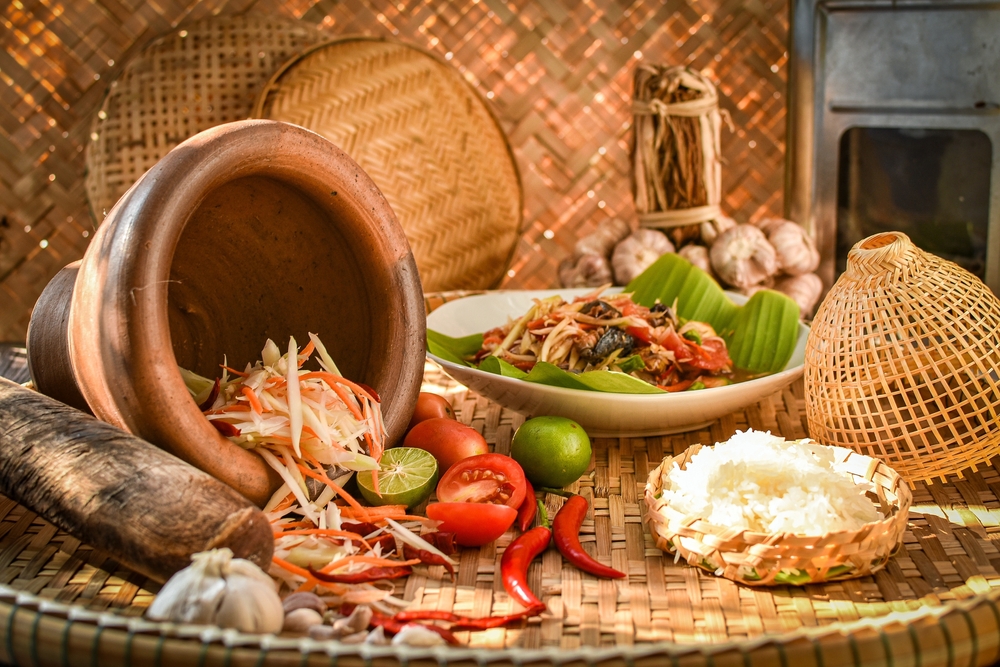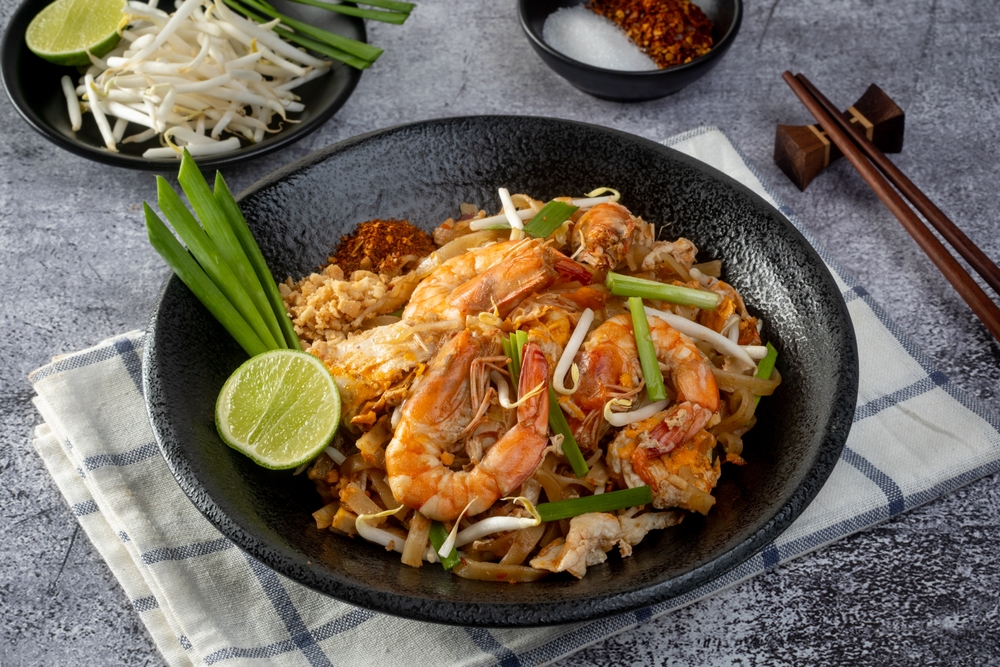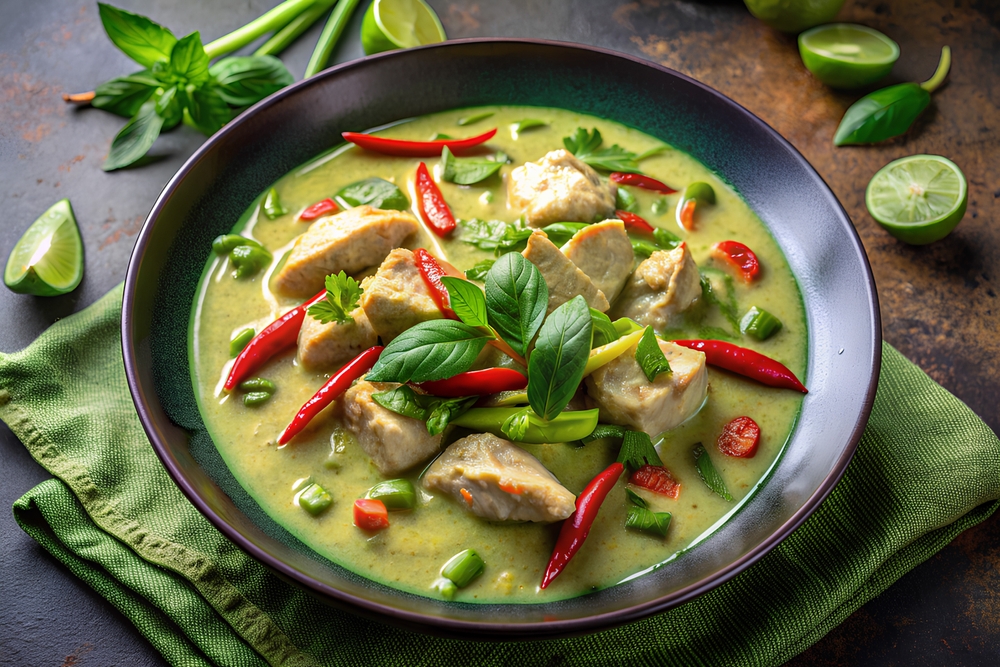A guide to Thai cuisine
A guide to Thai cuisine
Thailand isn’t just a country—it’s a sensory overload. The streets hum with life, motorbikes weaving between food carts that sizzle and smoke, perfuming the air with garlic, chili, and lemongrass. If you want to understand this country, start with its food.
Thai cuisine is a masterclass in controlled chaos. It thrives on contrasts—sweet and salty, fiery and soothing, crisp and unctuous. A spoonful of som tam, that fiery papaya salad, is a wild ride of crunch, tang, and raw heat. And if you’re not sweating just a little, you’re not doing it right.

But there’s more to it than spice. Thai food is about balance, shaped by geography and history. The Chinese brought noodles, the Indians their spices, the Malays their love of rich, slow-cooked curries. Over centuries, Thailand took it all, twisted it, refined it, and made it something unmistakably its own.
Take pad thai, for instance. It’s the dish everyone knows, but its story is more complex than the tangle of rice noodles on the plate. It wasn’t even widely eaten in Thailand until the mid-20th century, when a nationalist movement pushed for a national dish—one that was quick, affordable, and uniquely Thai. The result? A wok-seared meal of tamarind, fish sauce, and peanuts, a little sour, a little sweet, with just enough heat to keep things interesting. The kind of dish that tastes just as good from a street stall as it does in a high-end Bangkok restaurant.

And then there’s the ritual of eating. Meals here aren’t just about sustenance. They’re about sharing—plates passed around, spoons clinking against ceramic bowls, the casual camaraderie of a meal eaten together. There’s no rigid structure like in Western dining. Instead, it’s a mosaic of flavors meant to be sampled all at once—spicy, sour, salty, and sweet in one bite.
Venture deeper into Thailand, and you start to see the regional variations. The north, with its cooler climate and Lanna heritage, leans on fermented flavors and earthy broths. This is the home of khao soi, a coconut curry noodle dish, and sai ua, a sausage packed with herbs and chili.
The south, on the other hand, is all about intensity. Here, the curries are deeper, spicier, unafraid to make you sweat. Green curry, with its fragrant blend of fresh green chilies, lemongrass, and creamy coconut milk, is a dish that embodies Thai cooking’s ability to be both delicate and punchy at the same time. Spoon it over a steaming plate of jasmine rice, and you get a dish that’s both comforting and exhilarating, the heat creeping up on you between bites of tender chicken.

And then there are the street markets. Thailand’s real dining rooms aren’t inside—they’re on the sidewalks, where plastic stools and wobbly tables are the great equalizers. The best meals are eaten under flickering fluorescent lights, in the glow of charcoal grills. A vendor dishes out steaming bowls of boat noodles, their broth dark with soy sauce and rich from a splash of pig’s blood. Another tosses chicken onto a grill, its skin crisping under flames, to be served with nam jim jaew, a dipping sauce that somehow manages to be smoky, sour, and just the right amount of sweet.
But Thai food isn’t just about street food. It has its refined side, too. The art of royal Thai cuisine, with its meticulous knife work and balanced flavors, is a world away from the chaos of the night markets. Here, food is sculpted, plated with an artist’s precision, and infused with ingredients once reserved for the aristocracy. Yet even at its most elegant, Thai food never loses its soul.
The magic of Thai cuisine lies in its ability to be everything at once—spicy and soothing, simple yet intricate, a meal and a cultural statement all at once. It’s a cuisine that doesn’t hold back, that demands to be eaten with both hands, that lingers on your palate long after the last bite.
So pull up a plastic stool. Order something that scares you a little. Because in Thailand, the best meals aren’t just eaten. They’re lived.
There are two ways to eat in Thailand. One is to wander through the maze of sizzling woks and skewered meats, letting the smoky aromas pull you in. The other—arguably the smarter way—is to put your trust in those who know the backstreets, the unmarked doorways, and the decades-old stalls where generations have perfected their craft. A Chef’s Tour does just that, plunging you straight into the country’s culinary core, offering an unforgettable taste of its best-kept secrets.
Bangkok’s street food scene is as relentless as the city itself—chaotic, loud, but undeniably magnetic. Forget the tourist traps of Khao San Road. This tour takes you deep into the city’s twisting alleys, where stalls have been serving the same dishes to locals for years. Skewers of coconut-milk-marinated chicken sizzle over charcoal, ready to be dunked into rich, peanut-laced satay sauce. A backstreet stand dishes out fragrant, coconut-infused curry paired with cured sausage, an umami bomb of spice and creaminess. As the night deepens, Yaowarat Road glows neon, and the final stop delivers a sugary high, proving Bangkok’s food scene is nothing short of electric.
Phuket’s food scene tells the story of migration, trade, and centuries-old culinary fusion. Mainland Thai dishes take a backseat here; instead, Chinese and Malay influences dominate. You’ll bite into sticky fresh spring rolls, their delicate wrappers stuffed with herbs and sweet soy-braised pork. Chopsticks will wrap around prawn-filled Hokkien noodles, kissed by the flames of a well-seasoned wok. Then there’s gaeng som, a fiercely sour and spicy fish curry. By the end of the tour, your hotel’s green curry will never taste the same again.
Chiang Mai’s food is a mystery to most travelers, but this tour peels back the layers. Forget the Bangkok staples—this is a deep dive into bold, earthy flavors shaped by Burmese and Lanna influences. A steaming plate of khao ka moo (five-spice-braised pork) from the legendary “Cowgirl” sets the tone before you venture beyond the Old City walls. Smoky grilled pork, aromatic gaeng hang lae curry, and minced larb salad follow, each dish revealing another piece of the region’s food history.
These tours aren’t just about food; they’re about stories, culture, and a deeper understanding of Thailand’s culinary traditions. The best way to experience a country is through its street stalls—so grab a pair of chopsticks and dig in.